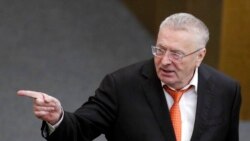The Kremlin and Chinese Communist Party are learning from each other in shaping and conducting information warfare aimed at exacerbating political divisions in the West and undermining trust in democracy, according to a new study.
While there’s only limited evidence of explicit cooperation, there are instances of narrative overlap, said the Center for European Policy Analysis, a Washington-based research organization.
According to the report, which focuses on disinformation campaigns since the late-2019 discovery of the coronavirus in Wuhan, China, Beijing's information warriors largely began by following the Russian "disinformation playbook,” copying disinformation narratives, tools and techniques, but now some simultaneous learning is taking place.
“During the COVID-19 pandemic, the Chinese Communist Party (CCP) spread disinformation about the efficacy of vaccines and the virus’s origins, a shift from Beijing’s previous disinformation campaigns, which had a narrower focus on China-specific issues such as Tibet, Hong Kong and Taiwan,” said researchers Ben Dubow, Edward Lucas and Jake Morris.
“Narrative overlap and circular amplification of disinformation show that China is following a Russian playbook with Chinese characteristics. Russia is simultaneously learning from the Chinese approach,” the authors said.
“The largest difference between China's and Russia’s information warfare tactics remains China’s insistence on narrative consistency, compared with Russia’s firehose-of-falsehoods strategy,” they added. “Even with substantially greater resources, this largely prevents Chinese narratives from swaying public opinion or polarizing societies.”
Thousands of websites
For the study, CEPA’s researchers assembled thousands of website articles and social media messaging from Russian and Chinese government officials and state-backed media from March 2020 through March 2021. That was complemented by an overview of research conducted by other groups and academic institutions into Russian and Chinese disinformation, which is defined as narratives based only partially on truth and purposefully meant to mislead.
“Russia largely followed its preexisting playbook of using crises to inflame tensions in foreign societies. China borrowed some tools from Russia but used them for different ends, sanitizing its own record and spreading conspiracy theories on a global scale,” said the study, “Jabbed in the Back: Mapping Russian and Chinese Information Operations During COVID-19,” which was released last week.
The day before the report was published, Meta, the parent company of Facebook and Instagram, announced it had removed more than 600 social media accounts linked to a Chinese influence operation that claimed the United States was pressuring the World Health Organization to blame COVID-19 on the Chinese government.
CEPA authors said China and Russia have used the pandemic as an excuse to try to further erode faith in democracy and wage information warfare against the West, opening another propaganda front in the growing competition between democratic and authoritarian governments.
Speaking Thursday in Washington on the first day of a virtual Summit for Democracy, U.S. President Joe Biden said it was a critical moment and called for democratic leaders to “lock arms” to show the world that democracies are far better vehicles for societies than autocracies.
U.S. Secretary of State Anthony Blinken warned Wednesday that the pandemic has heightened the challenges for democratic states, and he blamed “unscrupulous leaders” for spreading misinformation and disinformation.
The report said China continues to reject any Western blame for its handling of the outbreak. The Kremlin routinely denies accusations that it creates or perpetuates disinformation campaigns of any kind.
Designed to exploit divisions
Western officials say Russia and China have long aimed to weaken the United States, blunt the appeal of democratic institutions and exploit divisions, adding to polarization in the West. They say these governments have seized on the pandemic to enhance their international influence through disinformation operations.
Russian and Chinese information campaigns — using fake social media accounts and platforms such as Twitter to promote conspiracy theories amplified by state-run media outlets — are having a mutually reinforcing effect, they say.
According to the CEPA report, China and Russia have played a central role in spreading COVID-related disinformation. China has attempted to sanitize its record by promoting itself as the most effective global partner in combating the ailment, while Russian disinformation networks have focused on trying to undermine faith in Western efforts to curb the infection.
The report found that Chinese disinformation campaigns intensified in response to former President Donald Trump’s accusations that the coronavirus may have escaped from a Chinese lab in Wuhan, and then again after the U.S. intelligence community reported that same possibility to President Joe Biden.
Russia has innovated in spreading vaccine disinformation throughout Europe, CEPA said. In May 2021, it said, social media influencers in France and Germany were approached by a London-based group controlled from Moscow that offered to pay them to spread disinformation about the Pfizer vaccine.
The CEPA researchers also noted there are likely limits on any Sino-Russian convergence in the information environment. China information warriors follow more consistent and rigid narratives, presumably directed to do so by their bosses. While that gives the CCP more control over messaging, it leaves Beijing less successful than the Kremlin at tailoring content for specifically targeted audiences.











